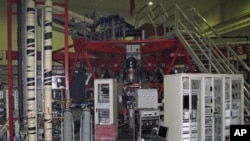The recent announcement from technological giant Lockheed Martin that it is perfecting a fusion reactor that it says will be functioning in three years has been met with skepticism.
Other researchers say that nuclear fusion as a sustainable source of power will not be achievable for decades.
Nuclear power was once thought to be the future of cheap electricity production. Today's reactors create power through fission, splitting the nuclei of heavy radioactive elements.
But after several accidents, most notably the 1986 explosion and meltdown of one of the reactors in Chernobyl, the public perception of nuclear power began to change.
Generating nuclear power is safe only while under strict control, with adequate shielding and temperature management.
Otherwise, the reactor’s core becomes too hot and explodes, contaminating the surrounding air, water and soil with long lasting radioactivity.
However, scientists have not abandoned the dream of harnessing the huge amount of energy released by atoms when they change their properties.
And fusion, the opposite nuclear process of fission, still holds the promise of an equally cheap but exponentially safer source of energy. It is the process that powers stars, fusing two atomic nuclei to release energy.
David Ingram, Chair of the Department of Physics and Astronomy at Ohio University, said the difficulty of harnessing nuclear fusion is that it requires a temperature as high as the surface of the sun in order to occur.
“The only way to do that is with either in fairly sophisticated magnetic fields or using a laser-driven system like the National Ignition Facility,” he said.
Ingram said that Lockheed appears to be taking a different approach — using a ‘magnetic mirror’ to confine the hot, electrically charged particles inside the reactor.
The fuel that powers fusion — a harmless mix of two hydrogen isotopes, deuterium and tritium — is abundant, and Ingram says that will make fusion reactors much less expensive to operate than the reactors now in use.
And he said they contain a million times more energy than the equal amount of coal.
Fusion reactors are also safer, said Michael Allen, an expert on nuclear power security at Middle Tennessee State University.
“There’s no residual decay heat or radioactive fission products, said Allen, an Engineering Technology professor. “If the power goes off it just shuts down. Also, it’s inherently safer because you cannot use it for nuclear weapons, as there’s no buildup of uranium or plutonium.”
Almost all of the world’s 400 fission reactors are close to the end of their lifetimes.
While they operate, these coal-fired facilities spew carbon dioxide into the atmosphere, creating pollution and accelerating climate change. So, Allen says, replacing them with new fusion technology can't happen soon enough.
Both the U.S. and European Union have been experimenting with fusion reactors; researchers say they do not expect them to be operational for decades.
However, Lockheed Martin says it may have a functioning prototype by 2017 and a marketable version by 2022.
The new reactor is being developed by the company's secretive Advanced Development Programs division called Skunk Works.
Researchers there were responsible for building such advanced aircraft as the SR-71 Blackbird and F-22 Raptor, which, Ingram said, gives them a degree of credibility.
“To be fair to them, the Skunk Works at Lockheed has been very successful in the past at projects like this,” Ingram said.
Expert Allen also thinks that Lockheed would have not gone public and applied for a patent for its fusion reaction unless they had some evidence that it would work.
And if it does, he said, it’s going to be huge.
“It’s going to be one of the biggest things that have ever happened to the mankind. It will be right up there with the invention of electricity, the invention of internal combustion engine, with the invention of PC, personal computers that we all have at home, the invention of the Internet," he said.





